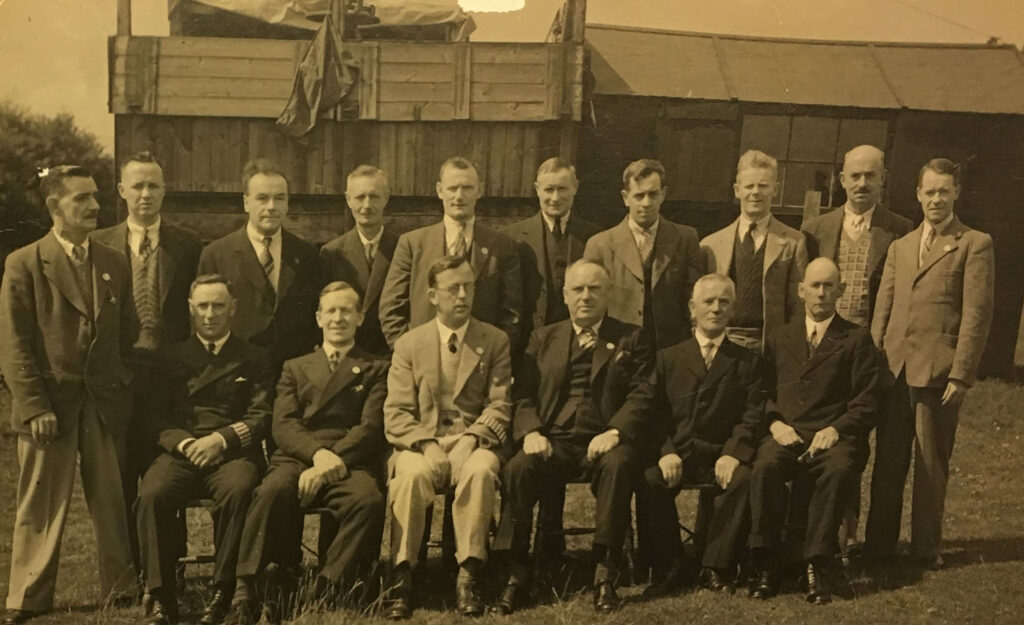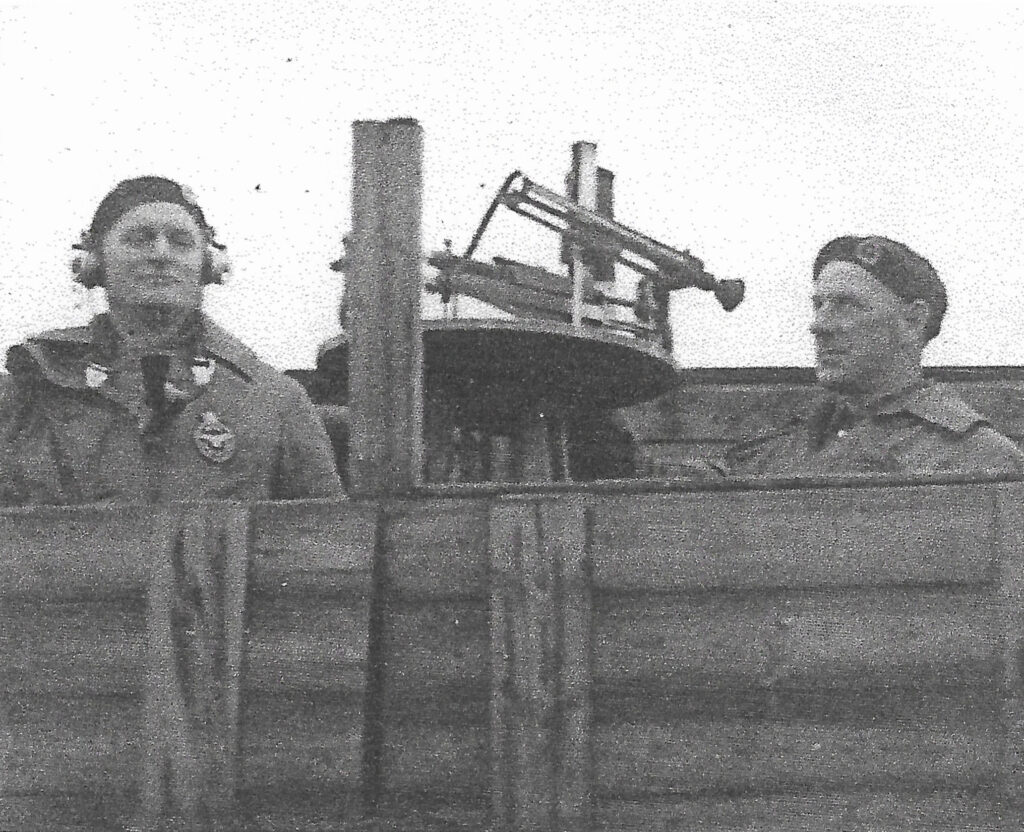In 1935, the Government created the Air Raid Precautions (ARP) Department. During the 1930s governments had become to believe that the next war would be won by air power and that immediate, devastating bombing raids would happen within days of the outbreak of war. The Air Raid Wardens’ Service was created in April 1937 and after the 1938 Munich Crisis the numbers enrolled increased dramatically. On 1st January 1938 the Air Raid Precautions Act came into force compelling all Local Authorities to begin creating their own ARP services – the passive defence services.
The ARP wardens’ role was to ensure that the blackout was observed, sound air raid sirens, issue gas masks and generally to instil order and stability and prevent chaos. ARP messengers, often too young to join the military, were to be used to take messages from air raid wardens to the control centre. Other specialist branches included first aid parties, ambulance drivers, gas decontamination squads, demolition squads for making safe bombed buildings, and road repair teams.
Regular classes were held in the National School to teach all aspects of passive defence and exercises were carried out to test transport and other problems. Registers of volunteer vehicles, drivers and civil defence personnel were all compiled.
On 3rd September 1939 war was declared on Germany after their invasion of Poland and on the same day the first ambulances arrived at the ARP Depot. By the following day the Towers had been commandeered by the military and converted into barracks. Two days after that the first evacuees arrived in the village.
The National School at the top of Church Lane was taken over as the “Armitage A.R.P. Depot” and became the HQ for all the village Passive Defence Personnel. An air raid shelter was built abutting the school and further shelters built around the village – there is one remaining, opposite Londis. A fire watcher scheme was put into place – stationed on the roof of the pottery – and the pottery also donated their fire engine for use of the village fire and rescue team for the duration of the war.

Armitage Observer Corps about 1942 Back row: T. Ratcliffe, Albert Conway, J. Ridley, Edgar Evans, J. Whitehouse, Fred Conway, John Goring, J. Martin, Henry Hodgkiss, Arthur Houghton Front row: Frank Timmis, Dave Johnson, Walter Hully, John Creed, J. Farroll, J. Glenn

Very little happened during the first twelve months of the war but in the spring of 1940 Denmark, Norway, Belgium and Holland were swiftly overcome and the Dunkirk evacuation took place. ARP vehicles were used to ferry Dunkirk wounded from Lichfield Trent Valley station to a new emergency hospital in Burntwood. During the summer of 1940, Luftwaffe aircraft began to appear over the district and the first air raid warning in Armitage was sounded on 25th June. On 29th June the first bombs to be heard in the village were dropped on Hoar Cross and on 8th August a parachute bomb was dropped near Rugeley Trent Valley railway station injuring a member of the Home Guard. On 27th August a bomb was dropped near Longdon.
On the night of 9th September 1940 the first bombs were dropped in the Parish of Armitage-with-Handsacre. The first bomb landed near Hawkesyard, the second near Langley Common then more in the Mill Meadows at the back of the church and Broad Meadows down Bromley Lane. A gas main was fractured causing a traffic problem but fortunately no-one was injured or killed.
On 18th October a single bomb fell in the meadow just 200 yards North East of Brick Kiln Farm making a crater thirty feet wide. The final bombs dropped in the area during the war was on 22nd October 1940 when a whole stick of bombs fell over Brereton . Fortunately some bombs failed to explode – one was not found until construction at Rugeley power station was started in the 1960s.
The records in the following table are largely from the 1939 Register which was taken on 29th September 1939. The information was used to produce identity cards and, once rationing was introduced in January 1940, to issue ration books. Information in the Register was also used to administer conscription and the direction of labour, and to monitor and control the movement of the population caused by military mobilisation and mass evacuation. It was designed to capture the details of every member of the civilian population on a specific date – military personnel were not recorded. The main details recorded were address, names, dates of birth and occupation, all of which were on the left hand side of the page. Other details were occasionally put on the right hand side which is largely cut off from images available from the genealogy internet sites but you can still see notes relating to additional civilian passive defence roles such as air raid warden.
As different roles emerged during the war some people switched their role e.g. Bill Wright stopped being the Traffic Control Officer and joined the Home Guard so he appears in both lists. (The Home Guard is on a separate record as it also covers Longdon and the Ridwares).
The Register was eventually used to produce the NHS database and also had some amendments to show married names of people who were single when the Register was first compiled.
If anyone has any additional information, please get in touch.
| Civil Defence Role | Surname | Forename |
|---|---|---|
| ARP HQ Staff 1st Div LRDC | Bailey | Eliza |
| ARP Messenger | Bond | Joseph W |
| ARP Demolition | Carthy | William H |
| ARP Demolition | Carthy | Charles E |
| ARP Messenger | Carthy | Charles E |
| ARP Messenger | Chadwick | James |
| ARP | Conway | Nellie |
| ARP | Conway | Miriam |
| ARP Warden | Edwards | James |
| ARP LRDC | Fielding | Frederick H G |
| ARP Demolition | Hall | Herbert |
| ARP Warden West Brom | Harford | Joseph |
| ARP | Hill | James |
| ARP Demolition | Hudson | Nora R E |
| ARP | Hully | Walter |
| ARP | Hulme | Eunice J |
| ARP Head Warden LRDC | Jackson | John |
| ARP Clerical West Brom | Jermine | Harriet M |
| ARP HQ Staff LRDC | Knight | Thomas F J |
| ARP messenger | Lawrence | Edgar G J |
| ARP | Leigh | Vedrene Claire |
| ARP Warden West Brom | Lewis | Harry |
| ARP Demolition | Manifold | William |
| ARP messenger | Manifold | George A |
| ARP Decontamination squad | Marklew | Francis H |
| ARP | Martin | Albert |
| ARP messenger | Merrick | Stanley |
| ARP Road repair gang | Morecroft | Harry |
| ARP | Neville | George H |
| ARP | Neville | Charles W |
| ARP | Neville | Tom |
| ARP | Osborne | Joseph H |
| ARP | Ottey | Alice M |
| ARP | Ottey | Hannah E |
| ARP | Quinby | George |
| ARP Decontamination squad | Rosson | Arthur C |
| ARP | Rowley | Harry E |
| ARP | Sawyer | John |
| ARP Decontamination Squad | Smith | William |
| ARP | Walker | Ellis H |
| ARP Decontamination Maidstone Kent | Waller | Fredk J |
| ARP Decontamination Squad | Waltho | James A |
| ARP | White | Thomas W |
| ARP | Winfindale | James E |
| ARP Transport Officer LRDC | Wright | William G |
| ARP | Wright | Harry |
| Fire service at E Johns & Co | Bayliss | William |
| Auxiliary Fire Service | Bailey | Cuthbert |
| Auxiliary Fire Service | Brinkworth | Jack |
| Auxiliary Fire Service | Carthy | Henry G W |
| Auxiliary Fire Service | Clarke | William |
| Auxiliary Fire Service | Flackett | Robert H S |
| Auxiliary Fire Service | Jones | Horace |
| Auxiliary Fire Service | King | George E |
| Auxiliary Fire Service | King | Bernard G |
| Auxiliary Fire Service | Leigh | Joseph |
| Auxiliary Fire Service | Lloyd | James |
| Auxiliary Fire Service | Mellor | Fredk G |
| Auxiliary Fire Service | Smith | John (Jack) |
| Nursing Auxiliary Service | Bailey | Judith C |
| St JAB ARP First Aid Rugeley | Bailey | Patrick R |
| Special Constable A Sec No 1 | Ball | Charles E |
| ARP nursing service | Bartlett | Hilda |
| Instructor in anti-gas measures & First Aid | Craddock | Herbert |
| ARP First Aid | Cubley | William H |
| ARP Service 1st Ambulance | Dawson | Joan |
| Civil Nursing Reserve | Gallimore | Gladys |
| First Aid worker Armitage | Hassall | Robert R |
| Local billeting officer | Jackson | Henrietta A |
| Voluntary ambulance driver | Jones | Margaret |
| ARP First Aid | Leech | Ernest |
| ARP First Aid | Lycett | Christopher |
| ARP First Aid | Lycett | Mary J |
| ARP Ambulance driver | Mellor | Albert |
| ARP First Aid | Morecroft | Graham A |
| ARP First Aid | Phillips | Margaret E |
| Nursing Reserve (army sister in last war) | Rhead | Alice |
| ARP First Aid | Samuel | Thomas J |
| ARP First Aid | Sedgwick | George G |
| ARP First Aid | Stott | Ethel B |
| ARP Emergency ambulance driver | Warner | Kate L |
| Surgeon to Rugeley St Johns Ambulance Brigade | Whiteside | John H |
| Observer Corps Group No 6 Unit Q2 | Conway | Frederick |
| Observer Corps Group No 6 Unit Q2 | Conway | Albert W |
| Observer Corps Group No 6 Unit Q2 | Evans | Reginald J T |
| Observer Corps Group No 6 Unit Q2 | Flackett | Robert |
| Observer Corps Group No 6 Unit Q2 | Fox | Charles E |
| Observer Corps Group No 6 Unit Q2 | Goring | John W |
| Observer Corps Group No 6 Unit Q2 | Hodgkiss | Henry |
| Observer Corps Group No 6 Unit Q2 | Houghton | Arthur T |
| Observer Corps Group No 6 Unit Q2 | Johnson | David |
| Observer Corps Group No 6 Unit Q2 | Lawrence | Fredk K |
| Observer Corps Group No 6 Unit Q2 | Martin | Albert J |
| Observer Corps Group No 6 Unit Q2 | Mountford | Harold |
| Observer Corps Group No 6 Unit Q2 | Ratcliffe | Edward I |
| Observer Corps Group No 6 Unit Q2 | Timmis | Frank |
| Observer Corps Group No 6 Unit Q2 | Ridley | J |
| Observer Corps Group No 6 Unit Q2 | Evans | Edgar E |
| Observer Corps Group No 6 Unit Q2 | Whitehouse | J |
| Observer Corps Group No 6 Unit Q2 | Hully | Walter |
| Observer Corps Group No 6 Unit Q2 | Creed | John |
| Observer Corps Group No 6 Unit Q2 | Farrell | J |
| Observer Corps Group No 6 Unit Q2 | Glenn | J |
